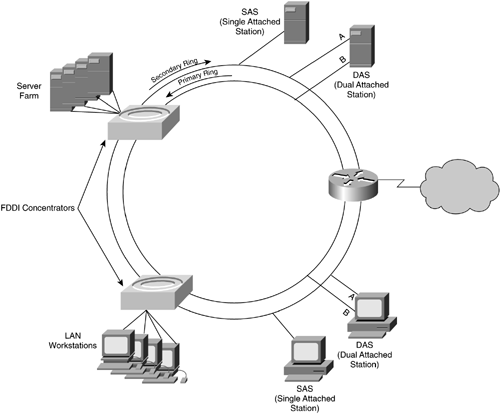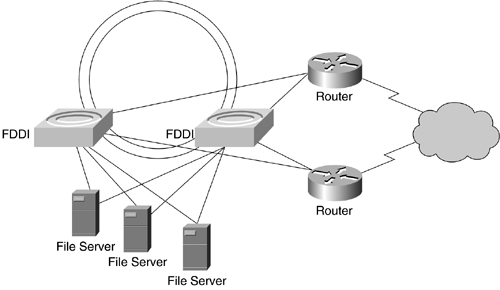FDDI
FDDI LANs were introduced in the mid-1980s as ANSI standard X3T9.5 and operate in a similar fashion to Token Ring LANs. FDDI LANs are a popular choice for LAN backbones because they have the following characteristics:
Operate at high speeds Data is transmitted around a FDDI ring at 100 Mbps.
Reliable Servers, workstations, or other network devices can be connected to dual rings. After a ring failure, a usable path on the other ring is automatically available.
Support a large network diameter Dual fiber-optic rings can have a network diameter of up to 100 kilometers each.
FDDI LANs are similar to Token Ring LANs because both are made up of a series of point-to-point links that connect a host to a host, a host to a concentrator, or a concentrator to a concentrator. FDDI specifies the use of fiber optic cabling for its infrastructure, but copper was later introduced and is supported by the Copper Distributed Data Interface (CDDI) specifications (similar to FDDI).
Figure 5-8 illustrates a FDDI LAN with single-attached stations (SAS), dual-attached stations (DAS), and FDDI concentrators (used to connect multiple stations to the FDDI LAN). To provide external access to a WAN, a router with dual-attached FDDI ports (ports A and B) is attached to the FDDI ring. Separate fibers are used in both transmit and receive directions, providing both an input and output point on each FDDI station.
Figure 5-8. FDDI Topology

Dual Homing
In an FDDI LAN environment dual homing is a fault-tolerant technique used for critical network devices, such as mainframes, server farms, or other mission-critical devices. In a dual-homed implementation, the host is attached to two FDDI concentrators, as illustrated in Figure 5-9.
Figure 5-9. FDDI Dual Homing Topology

Primary and Secondary Rings
FDDI trunks consist of two rings, known as a dual ring. During normal operation, traffic flows on the primary ring, where the secondary ring is the backup in the event the primary ring fails. In the instance of a primary ring failure, the systems adjacent to the break automatically reconfigure the ring path and create a new path that is a combination of both the primary and secondary rings, as illustrated in Figure 5-10.
Figure 5-10. FDDI Ring with Failed Primary Ring

The path length around the ring is limited to 200 kilometers. It is this limitation that restricts the LAN circumference of the dual-ring to 100 kilometers. If one of the rings fails, the dual-ring becomes a single large ring, combining the circumference distances of both the primary and secondary rings.
EAN: 2147483647
Pages: 269